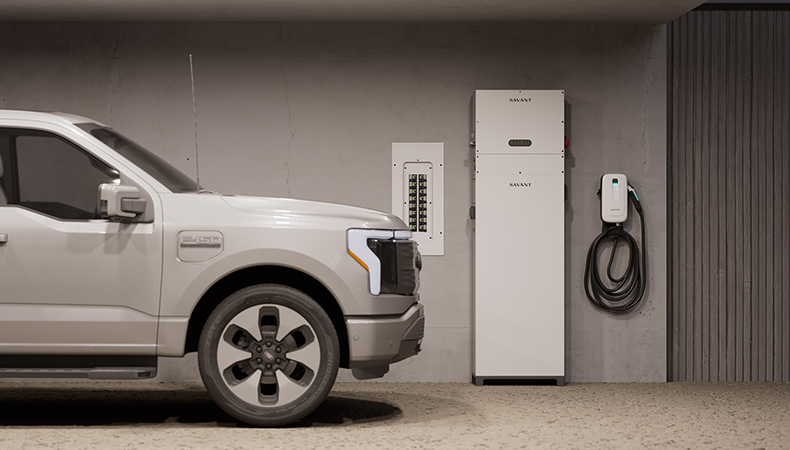Smart Power: Unlocking an eco-friendly future

In today’s rapidly evolving world, where smart devices and IoT (Internet of Things) integration continue to grow and evolve, it comes as no surprise that our power systems are also becoming smarter. Smart power systems like Savant Power are revolutionizing how we generate, distribute, and consume energy in our homes. As most people are still relatively unfamiliar with the benefits and how it works, we’re aiming to give you an overview of this new technology by delving into the benefits, exploring how it is reshaping the energy landscape, and making our lives more sustainable, efficient, and convenient.
Enhanced energy efficiency
One of the primary benefits of smart power is the improvement in energy efficiency. Traditional power systems have long been plagued by inefficiencies, such as energy losses during transmission and distribution, the inability to adapt to varying demand levels, and the ‘always on’ devices that draw power continuously. Smart power systems use advanced technologies like smart grids and real-time monitoring to minimize these inefficiencies.
Smart grids
At the heart of smart power lies the smart grid, a digitalized network that enables two-way communication between utilities and consumers. This grid intelligence allows for precise monitoring and control of energy flow, minimizing losses during transmission and distribution. Furthermore, it allows the integration of renewable energy sources, ensuring that clean energy is used wherever possible.
Demand response
Smart power systems allow homeowners to actively participate in energy management through demand response programs. With real-time data on energy consumption and pricing, users can adjust their usage patterns to reduce energy consumption during peak demand, which not only lowers their bills but also helps stabilize the grid.
Integration of renewable energy

The transition towards a sustainable future hinges on our ability to harness renewable energy sources effectively. Smart power plays a crucial role in achieving this by seamlessly integrating renewable energy into the grid.
Renewable energy sources like wind and solar are intermittent by nature, making grid stability a concern. Smart power systems address this challenge by using advanced forecasting and control mechanisms. This ensures that power generation from renewables is consistent and predictable, minimizing disruptions.
Smart power also allows for the efficient management of DERs (Distributed Energy Resources), including rooftop solar panels and home energy storage systems. These resources not only reduce strain on centralized power plants but also give consumers more control over their energy production and consumption.
Enhanced grid resilience
Climate change and extreme weather events are becoming more frequent and severe. Smart power systems bolster grid resilience, reducing the impact of such disruptions, keeping users online and powered up during even the most extreme weather patterns.
Many smart grids have self-healing capabilities that can isolate faults and reroute power automatically. This minimizes downtime during outages, improving service reliability for consumers. Advanced sensors and analytics in smart power systems also enable utilities to perform predictive maintenance on critical infrastructure. This helps identify potential issues before they cause widespread outages, saving both time and money.
Cost savings for consumers

Smart power is not just about utility companies; it also benefits users directly by reducing energy bills and offering cost-effective solutions.
Smart power systems provide users with access to energy management tools and apps such as the Savant Power app (seen above). These tools enable them to monitor their energy consumption in real-time, identify energy-wasting devices, and make informed decisions to reduce their electricity bills.
Many smart power programs, such as Savant, also take advantage of time-of-use pricing, where electricity rates vary based on demand. Consumers can take advantage of lower rates during off-peak hours, incentivizing them to shift energy-intensive activities to less expensive times.
Environmental sustainability
Reducing our carbon footprint remains a critical global initiative. Smart power contributes significantly to environmental sustainability by promoting clean energy adoption and reducing greenhouse gas emissions.
Carbon emissions reduction
The integration of renewable energy sources and increased energy efficiency directly translates into reduced carbon emissions. As more coal and gas-fired power plants are replaced with clean energy sources, the overall environmental impact of the power sector diminishes.
Electric vehicles
Smart power goes beyond electricity generation; it also supports the electrification of transportation. Electric vehicles (EVs) are a crucial part of the sustainable future, and smart power infrastructure facilitates their widespread adoption by offering convenient charging solutions.
Grid security and cybersecurity
As power systems become increasingly digital, the need for robust cybersecurity measures becomes paramount. Smart power systems invest heavily in security to protect critical infrastructure and data.
Data encryption and authentication
Smart grids use encryption and authentication protocols to secure data transmission and protect against unauthorized access. This safeguards sensitive information and prevents cyberattacks on the grid.
Grid isolation
In the event of a cyberattack, smart grids can isolate affected portions, preventing the attack from spreading to the entire network. This segmentation operates in a similar fashion to VLANs (a staple in home cybersecurity), where smart homes separate their dfevices from the main home network to minimize risk. This power segmentation enhances the grid’s overall security, reducing the risk of a large scale shutdown or breach.
Financial incentives

Inflation Reduction Act of 2022
Signed into law by President Joe Biden in late 2022, the Inflation Reduction Act aimed to curb pandemic-driven inflation by reducing budget deficit, lowering prescription drug prices, and investing in clean, domestic energy production. For homeowners, this meant the establishment of many new tax credits and rebates for investments in energy-efficient power solutions. Homeowners can now claim a 30% credit on any battery storage, a $600 tax credit and $6500 rebate for equipment and installation of smart power solutions and a $1000 tax credit for the installation of an electric vehicle charger.
HEAR
The Home Electrification and Appliance Rebate, expected to launch in late 2023 is a state-run program that provides further benefits for those installing and utilizing smart power solutions. With HEAR, homeowners are eligible for up to $6,500 on various wiring upgrades, and can save up to $4000 on any smart power installation in the form of rebates.
While smart power is the newest of the smart home technologies available to users, it is poised to transform the industry, fundamentally shifting how we generate, distribute, and consume energy. These benefits have widespread benefits for consumers and the environment alike. By improving energy efficiency, integrating renewable resources, offering cost savings, bolstering grid resilience, promoting sustainability, and ensuring grid security, smart power is paving the way for a brighter, cleaner, and more sustainable future.
Interested in bringing smart power to your home? Curious to learn more about the incentives and benefits? Visit us in our showroom in SoWa to see Savant Power in action and get hands-on experience with smart power!



